
|   |

|   |
 e-mail: leelakaverivenkat@gmail.com Anekanta provides exhilarating Bharatanatyam experience Photos: Sarabjit Singh Dhillon November 10, 2016 Woven round Jain philosophy of truth manifesting through multiple realities, Natya Vriksha's twenty-fifth anniversary, given founder Geeta Chandran's explorative creativity, became an exhilarating experience, for artists and audience - the performance at the packed Kamani auditorium in Delhi showcasing in a way, the elasticity of the Bharatanatyam technique in expressing off beat themes. What impressed was the overall package with the organisational details worked out meticulously. Inspired by the research of author Sudhamahi Regunathan, the two evenings could not have asked for a more fitting curtain-raiser than the scholar's own superb enunciation on the theme of Anekanta - of truth being relative, its entirety realised only by one who has attained that final state of consciousness ('Kaivalya'). Now more than ever perhaps the world needs to understand the wisdom enshrined in the philosophy that apparent contradictions are but manifestations of one ultimate harmony and that polarities can co-exist in perfect amity. 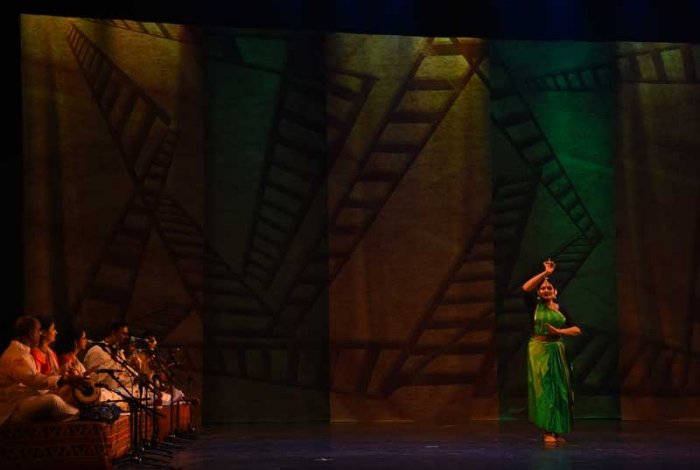 Working with abstract themes can be challenging for an artist whose mind comprehends the inter-linkages between dance and other disciplines from poetry and ancient texts to handicrafts and aesthetics. Geeta's solo performance began with an analogy of the word and its meaning forming a whole, reinforced in a metaphor of Kalidasa's verse in Kumarasambhavam "Vaakartha-vivasampruktau vaakarthav-pratipattaye..." where the togetherness of Shiva and Parvati as one inseparable unity (Jagatah-pitarau vande Parvati Parameshwarau) is likened to the word and its sense. The dance with just a stretched hand, followed by a leg extension, with the entirety of the dancer, in stages appearing from behind the excellent backdrop of ladders at various angles designed by Manish Kansara, was assisted by imaginative music sans needless embellishment - a feature of the evening. That multi-dimensional truth has several facets was symbolised in Lavanyatvam where Geeta interpreted the same libretto line of Vyasaraya's Pada "Krishna nee begane baro" (calling out to Krishna) in three different situations of vatsalya (mother calling out to the child), sringara (beloved beckoning to the loved one) and bhakti (devotee calling out to the Lord). The Jaina Anekanta philosophy finds resonance in the Rig Vedic verse "Ekam sat viprah bahuda vadanti" which was expansively treated through metaphors in a varnam like format showing the same truth reflected and experienced in various ways - like the shared breath of the universe, water in different forms like rivers merging into the unified identity of the ocean, life cycle where the seed after sprouting and bearing flower and fruit gets back to the seed form, sugarcane growing in different areas carries the same quality of sweetness much like many religions seeking the same truth. Fleshing out a bare-bone line through substantial images was difficult and the musical scaffolding in ragamalika form composed by K. Venkateshwaran, Dr. S. Vasu and Radhika Kathal provided excellent support. Sharanya Chandran's nattuvangam support, mellow mridangam accompaniment by Sriganesh with R. Raghavendra Prasath and Rajat Prasanna respectively on violin and flute completed the team. The music ushered in the happy sounds of Bahar, and went on to Behag, Pantuvarali and Bilahari, with the charanam with solfa passages in Malhar, Durga, Hameer Kalyani and Vasant. 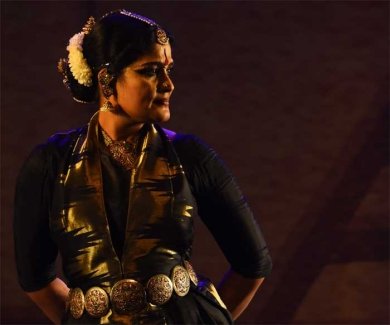 For this critic the best of the evening came in Geeta's visualisation of Ravana - bold for a female dancer with Sandhya Raman's creative costume a great asset in helping create a feel of the character. Setting out fully decked, Ravana's eyes fall on Sita with every part of her so perfect that eyes falling on any one part remain riveted on that spot. "If only I could snatch her and carry her off like an eagle flying in the high skies away from all." Geeta's abhinaya captured this enraptured Ravana very well. Opposites co-exist complementing each other, and with its frozen attitudes and vivacious rhythm, the Tillana in Tilang through Bharatanatyam adavus symbolised this inter-relatedness of the world, reflected in the concluding line "Aakashaat patitam toyam yatha gachhati sagaram..." that just like the waters from the skies fall to join the sea, Anekanta shows the oneness amidst differences in this universe. If the first evening laid out the Anekanta philosophy in its essentials, through an interaction of Jainism considered "dry and severe" with the efflorescence of Bharatanatyam, the second evening in group form underlined the putting into practice this acceptance of layered multiple realities coexisting in harmony, for ultimate truth defying description is realised only by the enlightened one. What emerged was a thoroughly professional group of very finished dancers performing in perfect coordination. As an example of multiple interpretations of the one universal truth, the starting Alarippu in tisram was cast in three variations, the three groups of dancers performing their respective movement while moving in different directions crossing stage space with all coming together on the 'sama' or first beat of the metrical cycle. Well thought out, the choreography despite the different groups performing together never looked cluttered or disorderly. 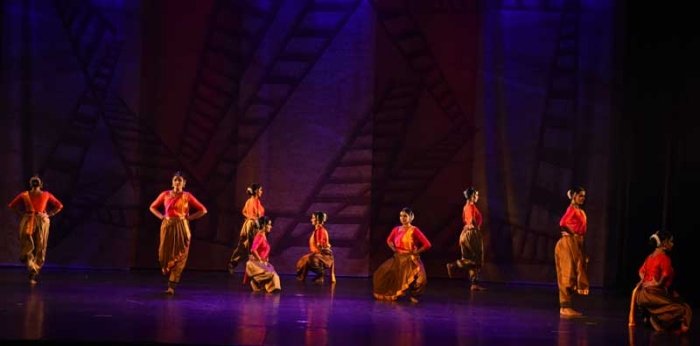 'Maya' or illusion is one of the factors much discussed in Indian thought - between what is said and what remains unsaid (vyakta and avyakta), between the tangible and the intangible, between form and formlessness (saguna and nirguna) are unseen forces creating a mirage of ignorance. Very intelligently Geeta used the keertana of Muttuswamy Dikshitar "Maaye" in raga Tarangini as the textual framework for her group choreography, the devotee pleading with the supreme abstract energy, seeking release from the grip of illusion. The way pairs of dancers showed being manipulated with sollu-s 'tat dit tom nom' (as if pulled like puppets on strings) was most imaginative. Rhythm and its intricacies which can create so many variations within one metric cycle had full play in Jati vistara. Here rhythmic beats juxtaposed against silences, beats at varying tonal levels of kanjeera and mridangam (Sriganesh), multi-percussion Pad (Prasanna Kumar), at different speeds, became a celebration of polarities. And the dancers were so perfectly rehearsed. The musical aspect of how the same set of notes can manifest in different forms was portrayed in Grihabheda, creating an aural Anekanta. When 'sa' the starting note is pushed to occupy the place of what was 'ri', the slide creates difference in melody with the same set of notes, and the experience of the note becomes different. Sruti bheda changes the raga and the shifted note evokes different emotions, reflected in movement, which gives expression to the note. Collectively this blended clever management of both music and movement. 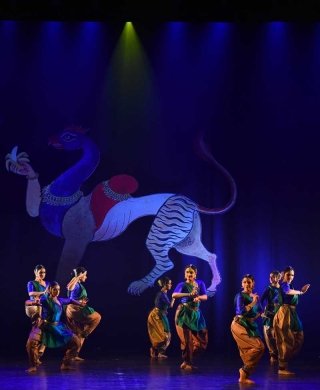 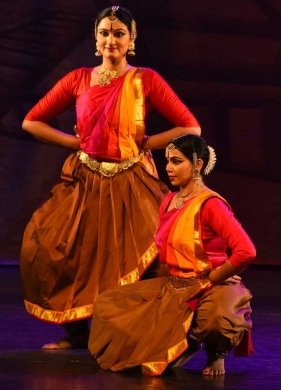
The perfect finale using an Annamacharya composition made very popular by late M.S. Subbulakshmi that Divinity takes on the form that the devotee offers homage to, was tagged on to a tale from Odisha's Sarla Das' Mahabharata where Arjuna is confused when confronted by a strange creature with a rooster's head and balanced on three feet each of an elephant, a deer and a tiger, the neck of a peacock, hump of a bull, the waist of a lion and tail of a snake. About to fight the beast, he then realises that this is a manifestation of Vishnu's Viswaroopa - informing him of his many manifestations - all aspects of the same one Truth. Manish Kansara's finely designed 'Navagunjara' drawing on the backdrop, the dancers making solo appearances portraying the various animals, and Geeta as Arjuna with the entire group joining in the tillana as a final celebration made for a memorable end to the two day fare.  Writing on the dance scene for the last forty years, Leela Venkataraman's incisive comments on performances of all dance forms, participation in dance discussions both in India and abroad, and as a regular contributor to Hindu Friday Review, journals like Sruti and Nartanam, makes her voice respected for its balanced critiquing. She is the author of several books like Indian Classical dance: Tradition in Transition, Classical Dance in India and Indian Classical dance: The Renaissance and Beyond. Post your comments Please provide your name and email id when you use the Anonymous profile in the blog to post a comment. All appropriate comments posted with name & email id in the blog will also be featured in the site. |